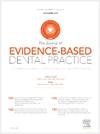种植体设计对同时引导骨再生治疗开裂缺损结果的影响:系统回顾与元分析
IF 4.1
4区 医学
Q1 DENTISTRY, ORAL SURGERY & MEDICINE
引用次数: 0
摘要
本系统综述和荟萃分析旨在确定种植体设计对同步引导骨再生(GBR)矫正开裂缺损结果的影响。方法在 MEDLINE (PubMed)、Cochrane Library 和 Embase 中采用结构化检索策略,以确定涉及种植体同步 GBR 矫正开裂缺损的前瞻性临床试验。收集了有关植入物特征、GBR 材料以及植入物植入和手术再入时的开裂缺损尺寸的数据。研究人员进行了 Meta 分析,以估算 (1) 基线开裂缺损尺寸、(2) 再次手术时缺损尺寸的变化以及 (3) 缺损完全愈合率的汇总平均值。尽管基线缺损尺寸相当,但与无领(NC)种植体(分别为 4.40 mm,95% CI [3.70,5.11] 和 3.23 mm,95% CI [2.72,3.75])相比,加工领(MC)种植体的高度增加幅度更大,亚组差异显著(P < .01)。具体而言,采用空间保持几何形状的 MC 治疗效果更佳。结论 GBR 的再生效果受植入物设计的影响。保持空间的机加工基台可提供帐篷效应,改善垂直骨增量。虽然还需要更多的研究来确定这些发现,并将有关种植体设计的选择纳入临床决策,但临床医生可以考虑复制这种效果,以提高治疗效果。本文章由计算机程序翻译,如有差异,请以英文原文为准。
Impact of Implant Design on Outcomes of Simultaneous Guided Bone Regeneration for Dehiscence Defects: A Systematic Review and Meta-Analysis
Objective
This systematic review and meta-analysis aimed to determine the implications of implant design on the outcomes of simultaneous guided bone regeneration (GBR) to correct dehiscence defects.
Methods
A structured search strategy was applied to MEDLINE (PubMed), Cochrane Library, and Embase, to identify prospective clinical trials involving implants with simultaneous GBR to correct dehiscence defects. Data regarding implant characteristics, GBR materials, as well as dehiscence defect dimensions at implant placement and surgical re-entry was collected. Meta-analyses were performed to estimate the pooled mean for (1) baseline dehiscence defect dimensions, (2) changes in defect dimensions at re-entry, and (3) prevalence of complete defect resolution.
Results
4298 unique records were identified, of which 21 studies with 680 implants were included. Despite having comparable baseline defect dimensions, greater height gains were achieved by implants with machined collars (MC) than noncollared (NC) implants (4.40 mm, 95% CI [3.70, 5.11] and 3.23 mm, 95% CI [2.72, 3.75] respectively), with significant subgroup differences (P < .01). Specifically, superior outcomes were observed for MC with space-maintaining geometries. However, there were no significant differences in the changes in defect width, prevalence of complete defect resolution, or the prevalence of postsurgical complication rates (P = .15, .54, and .18 respectively).
Conclusions
The regenerative outcomes of GBR were influenced by the implant design. Space-maintaining machined collars provide a tenting effect that improves vertical bone gain. While additional research is required to ascertain these findings and integrate choices regarding implant design into clinical decision-making, clinicians may consider replicating this effect to enhance treatment outcomes.
求助全文
通过发布文献求助,成功后即可免费获取论文全文。
去求助
来源期刊

Journal of Evidence-Based Dental Practice
DENTISTRY, ORAL SURGERY & MEDICINE-
CiteScore
6.00
自引率
16.70%
发文量
105
审稿时长
28 days
期刊介绍:
The Journal of Evidence-Based Dental Practice presents timely original articles, as well as reviews of articles on the results and outcomes of clinical procedures and treatment. The Journal advocates the use or rejection of a procedure based on solid, clinical evidence found in literature. The Journal''s dynamic operating principles are explicitness in process and objectives, publication of the highest-quality reviews and original articles, and an emphasis on objectivity.
 求助内容:
求助内容: 应助结果提醒方式:
应助结果提醒方式:


